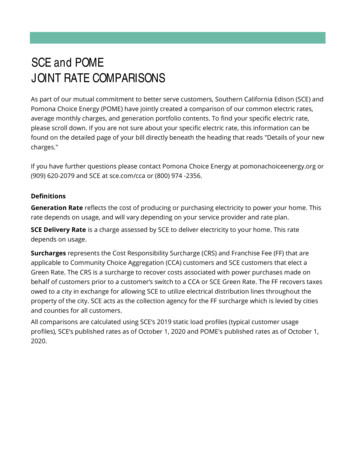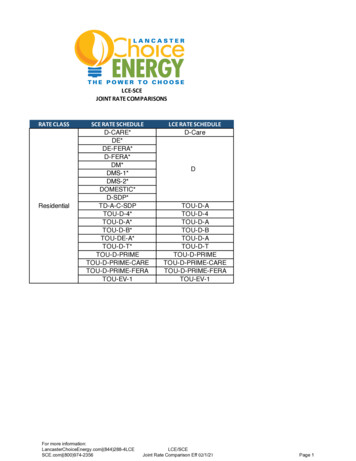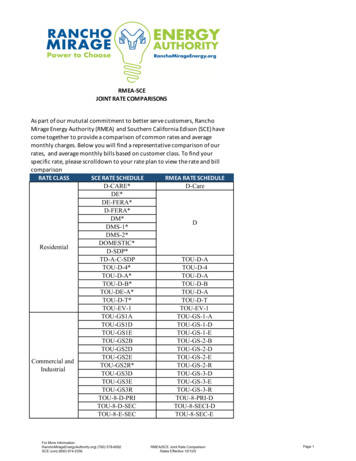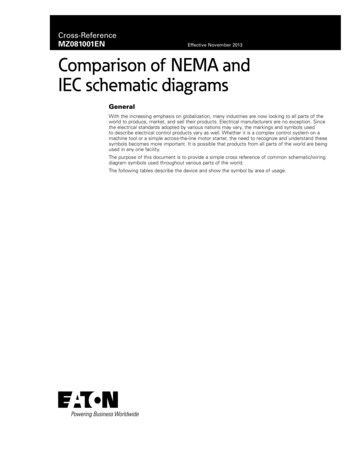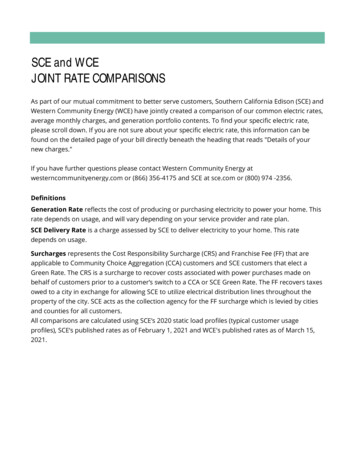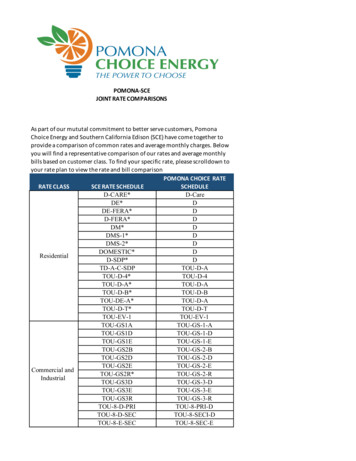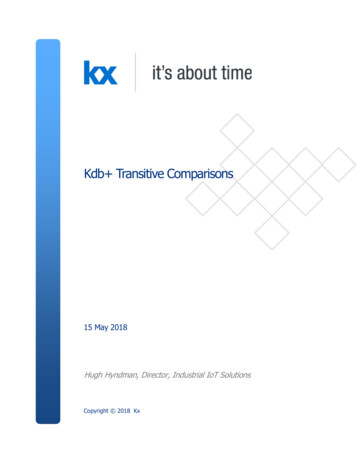
Transcription
Kdb Transitive Comparisons15 May 2018Hugh Hyndman, Director, Industrial IoT SolutionsCopyright 2018 Kx
Kdb Transitive ComparisonsIntroductionLast summer, I wrote a blog discussing my experiences running kdb on a Raspberry Pi, in particular makinguse of published benchmark content from InfluxData to generate test data, perform ingestion, and invoke aset of benchmarking queries. As a result of kdb ’s excellent performance, I concluded that it would be aperfect fit for small platform or edge computing.I felt that I owed it to the Kx community to take things a step further: to run performance tests against all ofthe products that InfluxData documented, including Cassandra, ElasticSearch, MongoDB, and OpenTSDB –and go beyond the Raspberry Pi and use a variety of other server configurations.The difficulty with doing this is that I didn’t have time to install and configure these technologies (let alone onthe Raspberry Pi), so I decided to take a different approach and exploit the old transitivity argument, where ifa is greater than b, and if b is greater than c, then it follows that a is greater than c.So, using this logic and taking InfluxData’s benchmark results at face value, I concluded that all I had to dowas run the tests on my hardware and compare my results with theirs to get a broad comparison across allthe other technologies. Moreover, as InfluxDB had pretty much outperformed all the other databases in theirtests, I reckoned that if kdb outperformed InfluxDB, then by transitivity, kdb was the fastest of them all!This article summarizes the data, queries and hardware environment that I used and the resultingperformance figures.DataThe raw data for the tests was based on capturing nine categories of system and application metrics (CPU,memory, disk, disk I/O, kernel, network, Redis, PostgreSQL, and Nginx) over a 24-hour period on a standardserver environment. Depending on the test being undertaken the data was extrapolated to varying numbersof servers (from 100 to 1,000) and different time periods (from 4 hours to 4 days).All data sets were based on 100 measurements every 10 seconds yielding quite small data sets (by kdb standards anyway as kdb can easily support trillions of data points) ranging from roughly 150 million to 850million entries. Because of this small size, I chose not to spread the data across multiple disks and partitionsto benefit from the parallelism inherent in kdb .QueriesThe table below summarizes the queries that InfluxData ran, and that I correspondingly ran on kdb , tocompare performance across other technologies. Note that the queries were not identical across eachtechnology in recognition of the fact that they are not all times-series databases (in particular, Cassandra,MongoDB and ElasticSearch are not) so the tests were attuned to gauge the effects of concurrency and otherperformance characteristics that yielded best results for each technology.1
Kdb Transitive ingQuery 1Return maximum value, by minute, in a 1-hour time frame, for 1 hostInfluxDB vs Cassandra1 dayQuery 2Return maximum value, by minute, in a 12-hour time frame, for 1 hostInfluxDB vs Cassandra1 dayQuery 3Return maximum value, by minute, in a 12-hour time frame, for 8 hostsInfluxDB vs Cassandra1 dayQuery 4Return maximum value, by minute, in a 1-hour time frame, for 1 hostInfluxDB vs ElasticSearch4 daysQuery 5Return maximum value, by minute, in a 1-hour time frame, for 1 hostInfluxDB vs MongoDB6 hoursQuery 6Return maximum value, by minute, in a 1-hour time frame, for 8 hostsInfluxDB vs OpenTSDB4 hoursUnlike the tests run in my previous blog, this time I ran the kdb queries between a test-harness client andthe kdb server, which provides a more apples-to-apples comparison of performance and introduces networklatency.HardwareI ran Queries 1 to 5 on kdb over three different platforms, small to large, including a Raspberry Pi, mypersonal MacBook Pro, and a fairly modest server. Their configurations and that of the InfluxData servers aredetailed as follows.PlatformCPURaspberry PiMemoryStorageOSDatabase1.2Ghz quad-core ARM 1GB DDR2-900 MHzCortex-A5332GB Micro SDHCRaspbiankdb (32-bit)MacBook Pro (mid2014)3Ghz Intel Core i7(2 cores)16GB DDR3-1600 MHz500GB SSD FlashMacOS 10.13.2kdb (64-bit)Kx Server*3.2Ghz quad-core E52667v3 Xeon (20MBcache)32GB DDR4-2133 MHz300GB SAS 10KCentOS 7.3.1611kdb (64-bit)InfluxData Server*3.6Ghz quad-core E51271v3 Xeon (8MBcache)32GB DDR3-1600 MHz1.2TB NVMe SSDUbuntu 16.04 LTSInfluxDB* denotes similar server configurations for head-to-head comparisonsThe configuration for Query 6 was different as the OpenTSDB tests and corresponding InfluxData tests wererun in the Amazon Cloud on a 2-core m4.xlarge EC2 instance. I ran my tests on the same instance type.ResultsThe table below summarizes the simple comparison of kdb versus other technologies by running the sixqueries on my Raspberry Pi, my MacBook Pro and three different specifications of the Kx Server described2
Kdb Transitive Comparisonsabove (i.e., using 1, 4, and 8 cores). The three rightmost columns indicate how much faster kdb is thanInfluxDB and, by transitivity, the other technologies.Let’s look at Query 6. If kdb is faster than InfluxDB by 32.5 times, and InfluxDB is 3.8 times faster thanOpenTSDB (i.e., 400 106 3.8), then by transitivity we can claim that kdb is 123 times faster than OpenTSDB.Kdb QueryRaspberry MacBookPiProInfluxDBTransitive erver4-coresHow muchfaster is kdb ?Technology:queries/secHow muchfaster is kdb ?14,74148,05525,06155,57879,0842,60621.3 Cassandra: 1,91229x24574,4873,44212,01921,08771416.8 Cassandra: 44227 3545315341,1011,9181925.7 Cassandra: 6617 41,33324,26612,45534,90553,6823,6009.7 ElasticSearch: 79442 57,69363,13856,649107,810122,6662,61441.2 MongoDB: 2,85038 68757,8045,36613,01817,09040032.5 OpenTSDB: 106123 Note: units above are in queries per secondsimilar server configurationsPerhaps a more dramatic way of presenting these numbers is by charting one of the queries. The chart belowshows the result of running Query 5 on kdb versus InfluxDB and MongoDB. The bars in blue are the resultsof my tests and the two rightmost bars are the results from the original InfluxDB tests.122,666120,000107,810Queries per ,6932,6142,850InfluxDBMongoDB0Raspberry PiMacBookServer 1-CoreServer 4-CoresServer 8-Coreskdb Query Rate: kdb vs InfluxDB vs MongoDBAs the kdb Server 4-Cores environment most closely resembles that of the InfluxDB server, we can use itsresults for our quick comparison. In this case, the processing of 107,810 queries per second by kdb compared to 2,614 by MongoDB represents a 41.2 times faster performance. Similar charts for each of theother queries are presented in the Appendix.3
Kdb Transitive ComparisonsSummaryKdb is well-known as the world’s fastest time-series database. We have industrial clients running kdb powered systems where up to 30-million sensor readings are being ingested per second, and over 10TB ofcompressed data being stored daily – all of this happening while multiple analytical queries and CEP are runagainst the database and inbound data streams.I have to admit that the design of the benchmark that InfluxData published does not accurately mimic realworld IIoT applications. The test database schema is simplistic, the volumes are small and the queries arerudimentary. Because the correct technology choice is so important, and because are so many vendors outthere with often lavish claims on their processing capabilities, at Kx we always impress upon our clients howimportant it is to base any technology choice on its performance at scale, with representative data volumes,actual ingestion load, and complex with multi-table time-series queries. This is the only way to accuratelyassess if the claims live up to reality and if the technology can truly serve the business. Any solution thatavoids such scrutiny should be similarly avoided itself.I am sure that it is apparent that the results are neither a scientific nor an independent assessment of kdb ’sperformance capabilities, but my demonstrating that kdb outperform other time-series databases by one ortwo orders of magnitude should give readers pause for thought.For a more rigorous view, I would suggest you visit Mark Litwintschik’s blog discussing the Billion Taxi RideBenchmarks tml).For completely independent and audited performance benchmarks, the STAC Benchmark Council has anumber of tests comparing low-latency, high volume technologies; kdb features well in STAC’s results. Youcan visit STAC at https://stacresearch.com.About Hugh HyndmanHugh Hyndman is the Director of Industrial IoT Solutions at Kx, based out of Toronto. Hugh has been involvedwith high-performance big data computing for most of his career. His current focus is to help companiessupercharge their software systems and products by injecting Kx technologies into their stack. If you areinterested in OEM or partnership opportunities, please contact Hugh. You can reach him throughsales@kx.com.4
Kdb Transitive ComparisonsAppendixThe following charts provide a graphic depiction of the performance differences amongst the various otherdatabase products.Queries 1, 2 and 3: Kdb vs InfluxDB vs Cassandra79,08480,000Query 1Query 2Query 370,000Queries per 1011,918Server 1-CoreServer 4-CoresServer 8-Cores2,606714 1921,912442660Rasp PiMacBookInfluxDBCassandrakdb 5
Kdb Transitive ComparisonsQuery 4: Kdb vs InfluxDB vs ElasticSearch60,00053,682Queries per ,0003,6001,333790Raspberry PiMacBookServer 1-CoreServer 4-CoresServer 8-CoresInfluxDBElasticSearchkdb 6
Kdb Transitive ComparisonsQuery 6: Kdb vs InfluxDB vs OpenTSDB20,00017,09018,000Queries per B6 Nodes0Raspberry PiMacBook Server 1-Core Server 4CoresServer 8CoresAWS 1-Core AWS 2-Coreskdb 7
Query Rate: kdb vs InfluxDB vs MongoDB As the kdb Server 4-Cores environment most closely resembles that of the InfluxDB server, we can use its results for our quick comparison. In this case, the processing of 107,810 queries per second by kdb compared to 2,614 by MongoDB represents a 41.2 times faster performance. Similar charts for each of the
